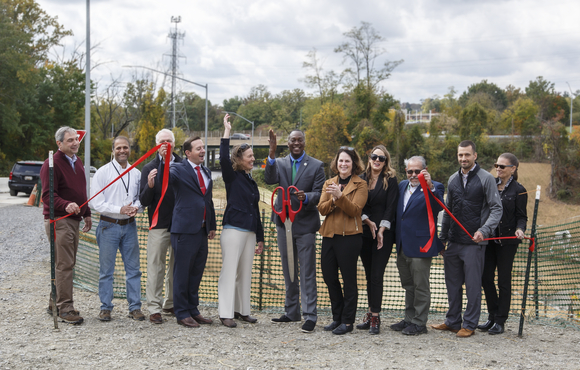ELLICOTT CITY, MD – Howard County Executive Calvin Ball today cut the ribbon on the largest Ellicott City public works project constructed to date designed to prevent stormwater from reaching Historic Ellicott City during major weather events. The H-7 pond, constructed on state land in a clover-leaf interchange at the intersection of Route 29 and Route 40/Baltimore National Pike in Ellicott City, can hold enough runoff to cover a football field to the height of 10 feet. Pictures from the event can be found here. Aerial footage of the project as it neared completion can be found here.
This pond is the first major public works project to be completed through our Ellicott City Safe and Sound plan and is one of the largest and most important projects in the history of Howard County,” said County Executive Ball. “While we can never eliminate the risk of flooding, we can do all we can to reduce the toll of devastating storms. We are making Ellicott City a national model of resilience.
While the pond will typically remain dry, it has the capacity to hold 4.24 million gallons of water, restricting its flow into the Tiber River watershed and away from Historic Ellicott City. The H-7 pond was constructed on State Highway Administration property.
The project cost $5.3 million to build, $4 million of which came from state funding. It was finished four months ahead of a projected completion date. In addition to creating the retention area, 110 trees and 1,800 native plants were planted.
As communities like Ellicott City have unfortunately experienced, climate change is an existential threat as extreme weather becomes more frequent and unpredictable. Thanks to County Executive Calvin Ball, today’s ribbon cutting marks the end of years of inaction under the previous Howard County administration. In addition, Senator Katie Fry Hester’s alongside Delegate Courtney Watson has enabled Maryland to secure nearly $1 billion in federal funds for future resiliency projects to keep Ellicott City and other vulnerable Maryland neighborhoods thriving in the years to come.
“I’m so proud to have worked with our state and local partners to bring more than $42M back for the Ellicott City Safe and Sound plan,” said Maryland State Senator Katie Fry Hester, Representing District 9. “We are a uniquely resilient city, and this retention pond is not your average infrastructure project – it’s part of a comprehensive solution to make our 250-year-old mill town a national model of climate resilience for the next 250 years.”
“Ellicott City residents can rest a little easier knowing this major storm water management project is complete,” said Maryland State Delegate Courtney Watson, representing District 9B. “This project is one important piece of the puzzle in creating a flood resilient historic Ellicott City. I thank the leadership of County Executive Ball for bringing this project into fruition and my Maryland General Assembly colleagues who backed our request for state funding.”
“The Ellicott City Partnership is thrilled about the tremendous progress being made on the Safe & Sound project,” said Jillian Joseph, Executive Director of the Ellicott City Partnership. “The H7 flood mitigation pond is a critical piece toward ensuring Historic Ellicott City's wonderful businesses and residents stay safe during a severe weather event and we are grateful to our partners in the County Executive's Office for making this a reality.”
The total anticipated investment of county, state, and federal dollars in Ellicott City to $167 million in the past four years, which is $138 million higher than during the previous four-year period.
After taking office in 2018, following the most recent deadly flood (Ellicott City endured flooding in 2011, 2016 and 2018) Ball said he tasked his team with developing a comprehensive solution for Ellicott City flood control, and looking for creative funding options. Components of the Ellicott City Safe and Sound Plan, which can be found at ecsafeandsound.org, also include:
- Seven major water retention and water conveyance projects;
- Enhanced stream cleaning;
- Tone alert warning system and signage; and
- Drainage improvements throughout the watershed.
